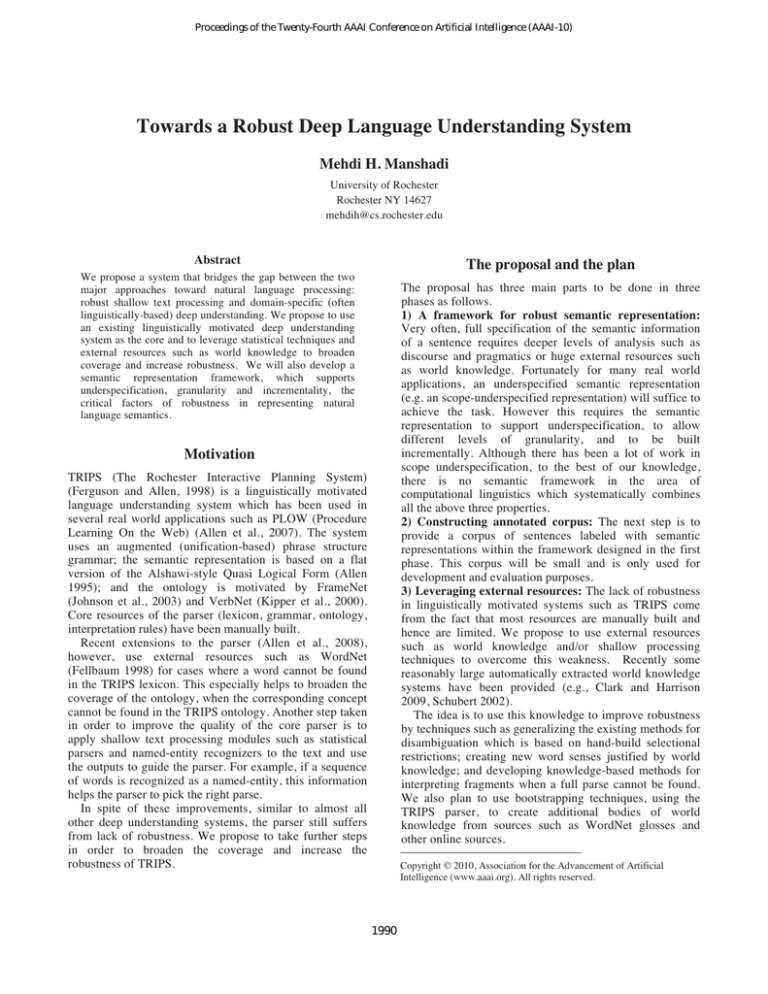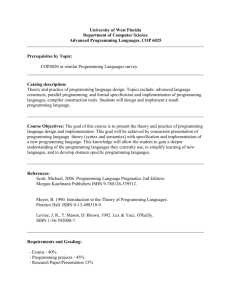
Proceedings of the Twenty-Fourth AAAI Conference on Artificial Intelligence (AAAI-10)
Towards a Robust Deep Language Understanding System
Mehdi H. Manshadi
University of Rochester
Rochester NY 14627
mehdih@cs.rochester.edu
Abstract
The proposal and the plan
We propose a system that bridges the gap between the two
major approaches toward natural language processing:
robust shallow text processing and domain-specific (often
linguistically-based) deep understanding. We propose to use
an existing linguistically motivated deep understanding
system as the core and to leverage statistical techniques and
external resources such as world knowledge to broaden
coverage and increase robustness. We will also develop a
semantic representation framework, which supports
underspecification, granularity and incrementality, the
critical factors of robustness in representing natural
language semantics.
The proposal has three main parts to be done in three
phases as follows.
1) A framework for robust semantic representation:
Very often, full specification of the semantic information
of a sentence requires deeper levels of analysis such as
discourse and pragmatics or huge external resources such
as world knowledge. Fortunately for many real world
applications, an underspecified semantic representation
(e.g. an scope-underspecified representation) will suffice to
achieve the task. However this requires the semantic
representation to support underspecification, to allow
different levels of granularity, and to be built
incrementally. Although there has been a lot of work in
scope underspecification, to the best of our knowledge,
there is no semantic framework in the area of
computational linguistics which systematically combines
all the above three properties.
2) Constructing annotated corpus: The next step is to
provide a corpus of sentences labeled with semantic
representations within the framework designed in the first
phase. This corpus will be small and is only used for
development and evaluation purposes.
3) Leveraging external resources: The lack of robustness
in linguistically motivated systems such as TRIPS come
from the fact that most resources are manually built and
hence are limited. We propose to use external resources
such as world knowledge and/or shallow processing
techniques to overcome this weakness. Recently some
reasonably large automatically extracted world knowledge
systems have been provided (e.g., Clark and Harrison
2009, Schubert 2002).
The idea is to use this knowledge to improve robustness
by techniques such as generalizing the existing methods for
disambiguation which is based on hand-build selectional
restrictions; creating new word senses justified by world
knowledge; and developing knowledge-based methods for
interpreting fragments when a full parse cannot be found.
We also plan to use bootstrapping techniques, using the
TRIPS parser, to create additional bodies of world
knowledge from sources such as WordNet glosses and
other online sources.
Motivation
TRIPS (The Rochester Interactive Planning System)
(Ferguson and Allen, 1998) is a linguistically motivated
language understanding system which has been used in
several real world applications such as PLOW (Procedure
Learning On the Web) (Allen et al., 2007). The system
uses an augmented (unification-based) phrase structure
grammar; the semantic representation is based on a flat
version of the Alshawi-style Quasi Logical Form (Allen
1995); and the ontology is motivated by FrameNet
(Johnson et al., 2003) and VerbNet (Kipper et al., 2000).
Core resources of the parser (lexicon, grammar, ontology,
interpretation rules) have been manually built.
Recent extensions to the parser (Allen et al., 2008),
however, use external resources such as WordNet
(Fellbaum 1998) for cases where a word cannot be found
in the TRIPS lexicon. This especially helps to broaden the
coverage of the ontology, when the corresponding concept
cannot be found in the TRIPS ontology. Another step taken
in order to improve the quality of the core parser is to
apply shallow text processing modules such as statistical
parsers and named-entity recognizers to the text and use
the outputs to guide the parser. For example, if a sequence
of words is recognized as a named-entity, this information
helps the parser to pick the right parse.
In spite of these improvements, similar to almost all
other deep understanding systems, the parser still suffers
from lack of robustness. We propose to take further steps
in order to broaden the coverage and increase the
robustness of TRIPS.
Copyright © 2010, Association for the Advancement of Artificial
Intelligence (www.aaai.org). All rights reserved.
1990
convert Penn Treebank trees into highly underspecified
semantic graphs, and then to incorporate all the existing
annotations of the Penn Treebank such as verb senses,
semantic roles, discourse information, etc. to incrementally
add more semantic information to the graphs. Human
annotators will then revise these automatically generated
semantic graphs in order to build gold standard semantic
representations for the selected portion of the Treebank.
Accomplished work
Although there has been a lot of work on scope
underspecification in semantic representation, previous
scope-underspecification frameworks suffered from either
limited expressivity or intractability. Therefore, as the first
step toward developing an underspecified representation,
we developed a framework that transcends the limited
expressivity of the previous formalisms and yet remains
tractable (Manshadi et al., 2008, 2009, 2010). We
presented polynomial-time algorithms for satisfiability and
enumeration of our formalism. Our framework also bridges
the gap between previous scope-underspecification
formalisms and brings them under a universal
representation.
As the next step, we developed a general framework for
semantic representation, called Semantic Graphs. In
semantic graphs, nodes specify the words or concepts,
solid edges represent the structural information and dotted
edges provide argument (semantic role) information. For
example figure (1) shows the semantic graph for the
sentence Every hungry dog chases a cat. Semantic graphs
not only allow for underspecification of quantifier scoping
but support underspecification of many other complex (and
often controversial) semantic phenomena such as word
senses, semantic roles, etc. At the same time, the
framework supports different levels of granularity in
underspecification. For example, semantic roles form a
hierarchical structure in which upper nodes represent
coarse-grained roles, and lower nodes represent finegrained roles. Collapsing and expanding the nodes of a
graph also achieve granularity. For example, if no syntactic
tree is available for a sentence, but the chunking
information is provided using a NP-chunking module, then
the whole noun phrase can be represented as a composite
node, which can later be expanded if further processing
becomes available.
Semantic graphs provide incrementality by supporting
different depths of analysis from part of speech tagging to
discourse and pragmatics analysis. In fact, every
processing level incrementally adds new information to the
graph by building new nodes, adding new edges, and
updating labels (of nodes/edges) to more fine-grained ones.
Future work
The next step will be to incorporate external resources such
as world knowledge into TRIPS as mentioned above. We
will use knowledge bases such as DART (Clark and
Harrison 2009) for this purpose. We will also explore using
statistical processing techniques such as semi-supervised
learning methods in a bootstrapping fashion on the cheaply
available unlabeled data to improve the quality of the
system. All these systems will be evaluated on the gold
standard annotated data provided in phase 2.
References
Allen, J. (1995) Natural Langue Understanding, BenjaminCummings Publishing Co., Inc.
Allen, J. F., Swift, M. and Beaumont, W. (2008) Deep
Semantic Analysis for Text Processing. Semantics in
Systems for Text Processing (STEP 2008).
Allen, J., Chambers, N., Ferguson, G., Galescu, L., Jung,
H., Swift, M., and Taysom, W. (2007). PLOW: A
Collaborative Task Learning Agent. AAAI-07.
Clark, P., Harrison, P. (2009) Large-Scale Extraction and
Use of Knowledge From Text. KCap-09.
Fellbaum C. (1998), WordNet: An electronic lexical
database , The MIT Press, Cambridge, MA.
Ferguson, G. and Allen, J. (1998) TRIPS: An Intelligent
Integrated Problem-Solving Assistant, AAAI-98.
Johnson, C., M Petruck, et al., (2003), FrameNet: Theory
and practice. Berkeley, California.
Kipper, K., H. T. Dang, and Palmer, M., (2000) Classbased construction of a verb lexicon. AAAI-2000.
Manshadi, M, Allen, J., and Swift, M. (2009) An efficient
enumeration algorithm for underspecified semantic
representations. Formal Grammar, Hamburg, Germany.
Manshadi, M, Allen, J., and Swift, M. (2008) Toward a
Universal Underspecifed Semantic Representation.
Formal Grammar (FG 2008), Hamburg Germany.
Manshadi, M, Allen, J., and Swift, M. (2010) A universal
framework for underspecified semantic representation.
Forthcoming.
Marcus, M. P., Santorini B., and Marcinkiewicz M. A.
(1993) Building a Large Annotated Corpus of English:
The Penn Treebank, Computational Linguistics, Volume
19, Number 2 (June 1993).
Schubert, L. K., (2002), Can we derive general world
knowledge from texts? , Human Language Technology
Conference (HLT 2002), San Diego, CA, 2002.
Ongoing work
At the moment we are annotating a small part of the Penn
Treebank (Marcus et al., 1993) with semantic graphs. Our
approach is to design some interpretation rules which
1991








